What is a prairie?

Figure A. Big Bluestem.
The word prairie comes from the French word meaning "meadow," which the early European settlers adopted for the unfamiliar North American grassland (Packard and Mutel 1997). As its name suggests, the most obvious feature of the tallgrass prairie in Illinois was big bluestem (Andropogon gerardi, Figure A), a grass species that can reach heights of eight or nine feet (Ladd 1995).
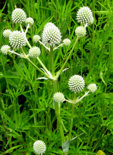
Figure B. Rattlesnake Master.
The Illinois Prairie contained over three hundred species of grasses and flowers, for example, rattlesnake master (Eryngium yuccifolium, Figure B), purple prairie clover (Dalea purpurea, background), and butterfly milkweed (Asclepias tuberosa, Figure C).
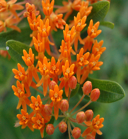
Figure C. Butterfly Milkweed.
The tallgrass prairie depended upon fires for its survival. Historically, fires set by Native Americans or started by lightning would eliminate the trees that would compete with prairie plants (McClain 1997, Figure D). The prairie was home to a number of interesting animal species such as bison (Bison bison), the greater prairie chicken (Tympanuchus cupido, Figure E), and the plains wolf (Canis lupus, which was exterminated before the beginning of the 20th century (Fischer 1967).
Why this prairie plot is important
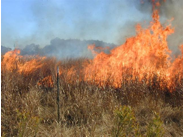
Figure D. Prairie Fire.
Prairie plants can withstand drought and they provide important wildlife habitat. This prairie plot, which was a student initiative, was established in the spring of 2009. All of the seeds were collected, bought, or donated by Illinois Wesleyan students and members of the community. The prairie is also maintained by Illinois Wesleyan students.
Acknowledgements
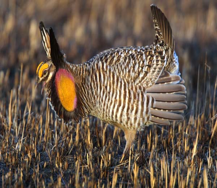
Figure E. Greater Prairie Chicken.
Special thanks goes to Kelly Peterson (class of 2010) for initiating this project and collecting the majority of the seeds; the Sierra Student Coalition for providing financial assistance for the purchase of seeds and the sign; Dr. Given Harper for advising and supervising this project; Mr. Donald Schmidt for providing important planting information and growing plants in the Illinois State University greenhouse; Meaghan Collins (class of 2009) for growing the plants from seeds in the greenhouse and transplanting them to the plot.
References
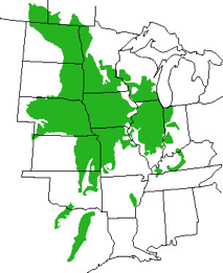
Figure F. Distribution of the
prairie before European
settlement.
- Ladd, D. 1995. Tallgrass Prairie Wildflowers a Field Guide. The Globe Pequot Press.
- McClain, W.E. 1997. Prairie Establishment and Landscaping. Division of Natural Heritage Illinois Department of Natural Resources.
- Packard, S., Mutel, C.F. 1997. The Tallgrass Restoration Handbook For Prairies, Savannas, and Woodlands. Society for Ecological Restoration.
- Robertson, K. 2007. The Tallgrass Prairie in Illinois [Internet]. Champaign (IL): University of Illinois; 2008 June [cited 2009 Feb 4]. Available from http://www.inhs.uiuc.edu/~kenr/tallgrass.html.